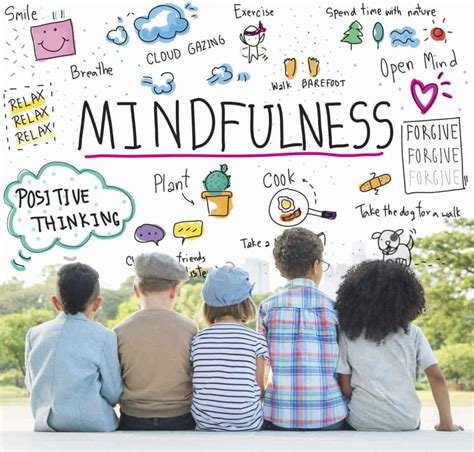The Benefits of Mindfulness for Children: Techniques for Teaching Mindfulness
In today’s fast-paced and constantly changing world, children are facing a multitude of stressors that can negatively impact their mental health and well-being. This is where the practice of mindfulness comes in. Mindfulness, which involves focusing one’s awareness on the present moment, has been proven to have numerous benefits for children, including improved mental health, better focus and concentration, enhanced emotional regulation, and increased empathy.
In this blog post, we will explore the various ways in which mindfulness can positively impact children’s lives. From breathing exercises and guided visualization to mindful eating and sensory awareness exercises, there are numerous techniques that can be used to introduce mindfulness to children. We will also delve into the relationship between mindfulness and emotional regulation, as well as its impact on children’s social interactions and empathy.
Additionally, we will discuss practical strategies for incorporating mindfulness into children’s daily routines, ultimately helping them lead happier and healthier lives. Join us as we explore the benefits of mindfulness for children and learn effective techniques for teaching mindfulness to the next generation.
What is mindfulness and why it is important?
Mindfulness is the practice of paying attention to the present moment, without judgment. It involves being fully aware of your thoughts, feelings, and surroundings, as well as being in tune with your body and emotions. This practice has been shown to have numerous benefits for both children and adults, including reduced stress, improved focus, and better emotional regulation.
One of the reasons why mindfulness is important is because it helps children develop a greater sense of self-awareness. By learning to pay attention to their thoughts and feelings, children can better understand themselves and their emotions, leading to improved self-esteem and confidence. Additionally, mindfulness has been shown to have a positive impact on mental health, with studies suggesting it can reduce symptoms of anxiety and depression in children.
Furthermore, mindfulness can help children improve their ability to concentrate and focus. By practicing mindfulness exercises, children can learn to better control their attention and regulate their impulses, leading to improved academic performance and behavior. It also teaches children to be more present in the moment, which can lead to an overall sense of calm and wellbeing.
Overall, mindfulness is an important practice for children because it can help them develop crucial skills for emotional and mental wellbeing, as well as improve their ability to concentrate and focus. By introducing mindfulness to children at a young age, they can develop these skills early on and carry them into adulthood.
The positive effects of mindfulness on children’s mental health
Mindfulness is a powerful tool that can have numerous positive effects on children’s mental health. It can help children develop a greater sense of awareness and understanding of their emotions, which in turn can lead to improved emotional regulation and reduced stress levels. By practicing mindfulness, children can learn to manage their thoughts and feelings in a healthy way, leading to a more positive outlook on life.
Furthermore, mindfulness has been shown to have a positive impact on children’s ability to focus and concentrate. Through various mindfulness-based activities such as breathing exercises and guided visualization, children can learn to be more present in the moment and less affected by distractions. This can lead to improved academic performance and overall cognitive function.
Additionally, teaching children about mindful eating can help them develop a greater sense of gratitude and self-awareness. By encouraging children to pay attention to the taste, texture, and smell of their food, they can learn to appreciate the nourishment that food provides and develop a healthier relationship with eating.
Overall, the positive effects of mindfulness on children’s mental health are vast and far-reaching. By incorporating mindfulness into their daily routines, children can develop valuable skills that will benefit them both now and in the future.
Teaching children mindfulness through breathing exercises
Mindfulness is the practice of paying attention to the present moment, without judgement. It has been shown to have many benefits for both adults and children, including reduced stress, improved focus, and better emotional regulation. Teaching children mindfulness through breathing exercises is a great way to introduce them to the concept and help them develop important skills for their mental and emotional well-being.
One simple breathing exercise that can be used to teach mindfulness to children is belly breathing. This involves taking deep breaths in through the nose, allowing the belly to rise, and then exhaling slowly through the mouth. This type of breathing helps children to focus on the physical sensations of their breath, which can help to calm their minds and bodies.
Another effective breathing exercise for children is the flower and candle visualization. In this exercise, children imagine that they are smelling a beautiful flower as they breathe in, and then blowing out a candle as they exhale. This visualization can be a fun and engaging way to help children practice mindful breathing while also using their imagination.
It’s important to remember that teaching children mindfulness through breathing exercises should be done in a gentle and encouraging manner. It’s also helpful to practice these exercises with children regularly, so that they can become more comfortable with the concept of mindfulness and develop their skills over time.
The role of guided visualization in teaching mindfulness to children
Guided visualization is an effective tool for teaching mindfulness to children, as it allows them to use their imagination to focus on specific images or scenarios, which can help them develop a sense of calm and relaxation. Through guided visualization, children can learn to pay attention to their thoughts and feelings, and practice self-awareness and emotional regulation.
Using guided visualization as a mindfulness strategy can also help children improve their concentration and focus, as they learn to direct their attention to the present moment. By engaging in guided visualization exercises, children can develop the ability to stay present and attentive, which can be beneficial for their overall mental well-being.
Furthermore, guided visualization can be used to teach children about the importance of positive thinking and optimism. By visualizing themselves in positive and uplifting scenarios, children can cultivate a positive mindset and learn to approach challenges with a sense of resilience and hope.
Incorporating guided visualization into mindfulness activities for children can also enhance their creativity and imaginative skills. By encouraging children to create and visualize their own peaceful and calming scenes, they can tap into their creative potential and expand their capacity for imagination.
Benefits of mindfulness-based activities for children’s concentration and focus
Mindfulness-based activities have been shown to have numerous benefits for children’s concentration and focus. When children engage in activities such as meditation, yoga, or deep breathing exercises, they learn how to calm their minds and focus on the present moment. This can be especially helpful for children who struggle with attention issues or hyperactivity, as it teaches them to redirect their energy and thoughts towards a specific task or activity.
Additionally, mindfulness-based activities help children develop self-regulation skills, which are essential for maintaining attention and focus. By learning to be aware of their thoughts and emotions, children can recognize when they are feeling distracted or unfocused, and can then use mindfulness techniques to bring their attention back to the present moment. This can be especially beneficial in academic settings, as it can help children stay focused during class and while completing homework assignments.
Furthermore, engaging in mindfulness-based activities can improve children’s overall emotional well-being, which can in turn improve their ability to concentrate and focus. When children are less stressed and anxious, they are better able to pay attention to the task at hand and maintain their focus for longer periods of time. By incorporating mindfulness into their daily routines, children can develop a sense of inner calm and focus that can positively impact their academic and personal lives.
In conclusion, incorporating mindfulness-based activities into children’s lives can have a significant impact on their concentration and focus. By teaching children to be present in the moment and to regulate their thoughts and emotions, mindfulness helps them develop the skills they need to stay focused and attentive in various aspects of their lives. As a result, children who engage in mindfulness-based activities are better equipped to handle academic challenges, manage their emotions, and maintain their concentration and focus on the task at hand.
Using mindful eating to teach children about gratitude and self-awareness
Mindful eating is a powerful tool for teaching children about gratitude and self-awareness. By practicing mindful eating, children can learn to appreciate the food they have in front of them, to be present in the moment, and to develop a deeper understanding of where their food comes from.
When children are encouraged to engage in mindful eating, they are taught to slow down and savor each bite, paying close attention to the taste, texture, and smell of their food. This practice not only helps them become more aware of their senses, but it also fosters a sense of gratitude for the nourishment that food provides.
Moreover, mindful eating can also help children develop a healthier relationship with food and their bodies. By encouraging them to listen to their bodies’ hunger and fullness cues, children can learn to eat in a way that honors their natural instincts and fosters a positive self-image.
Overall, using mindful eating as a tool to teach children about gratitude and self-awareness can have a profound impact on their overall well-being, helping them develop a deeper appreciation for the food they eat and a healthier relationship with their bodies.
The relationship between mindfulness and emotional regulation in children
Mindfulness, the practice of being aware of the present moment without judgment, has been shown to have a powerful impact on children’s emotional regulation. When children engage in mindfulness activities, they learn to recognize their emotions without reacting impulsively. This heightened awareness allows them to respond to the emotions in a more thoughtful and controlled manner, leading to improved emotional regulation.
Research has demonstrated that children who practice mindfulness regularly are better able to manage stress and anxiety. By incorporating simple mindfulness exercises into their daily routines, children learn to focus on their breath, body sensations, and the world around them, which helps them develop a greater sense of calm and emotional stability.
In addition, mindfulness teaches children to be more compassionate and empathetic towards themselves and others. Through mindfulness practices such as loving-kindness meditation, children learn to cultivate positive emotions and develop a greater sense of connection with the world around them. This enhanced sense of empathy and compassion contributes to their ability to regulate their emotions in a more positive and adaptive way.
Overall, the relationship between mindfulness and emotional regulation in children is clear. By practicing mindfulness, children develop the skills necessary to recognize, understand, and manage their emotions, leading to improved emotional well-being and a greater sense of resilience.
Introducing mindfulness through sensory awareness exercises for children
Mindfulness is the practice of being present in the moment and being aware of our thoughts, feelings, and sensations without judgment. It is an important skill for children to develop as it can help them manage stress, improve their focus, and regulate their emotions. Introducing mindfulness through sensory awareness exercises can be a fun and effective way to teach children these valuable skills.
One way to introduce mindfulness to children is through sensory awareness exercises. This involves paying attention to the present moment using the five senses – sight, hearing, touch, taste, and smell. For example, children can be encouraged to focus on the sounds they hear, the colors they see, and the textures they feel. By doing so, they become more attuned to their surroundings and develop a greater sense of awareness.
Sensory awareness exercises can take many forms, such as mindful walking, where children pay attention to each step they take, or mindful eating, where they focus on the taste, texture, and smell of their food. These exercises not only promote mindfulness but also encourage gratitude and self-awareness. They can help children appreciate the simple joys of life and become more in tune with their bodies and emotions.
By incorporating sensory awareness exercises into their daily routines, children can learn to be more present and attentive, which can have a positive impact on their overall well-being. These exercises can also be a great way for parents and educators to bond with children and teach them valuable life skills in a fun and interactive way.
The impact of mindfulness on children’s social interactions and empathy
Mindfulness practices have been shown to have a significant impact on children’s social interactions and empathy. When children are taught to be present in the moment and to be aware of their thoughts and emotions, they are more likely to exhibit empathy towards others. Mindfulness helps children to develop a greater sense of emotional regulation, which can lead to more positive and empathetic social interactions with their peers.
Furthermore, practicing mindfulness can also help children to develop empathy by encouraging them to be more aware of the feelings and emotions of those around them. By tuning into their own emotions during mindfulness exercises, children can become more attuned to the emotions of others, which can lead to more empathetic and compassionate behaviors.
Research has shown that mindfulness-based activities, such as mindful listening and mindful communication, can improve children’s social skills and ability to relate to others. By learning to focus on the present moment and to listen and communicate mindfully, children can become more attentive and responsive in their interactions with others, leading to deeper and more meaningful relationships with their peers.
In conclusion, incorporating mindfulness into children’s daily routines can have a positive impact on their social interactions and empathy. By teaching children to be present, attentive, and aware of their own emotions and the emotions of others, mindfulness can help to foster empathetic and compassionate behaviors, ultimately leading to more positive and fulfilling social relationships.
Strategies for incorporating mindfulness in children’s daily routines
One effective strategy for incorporating mindfulness into children’s daily routines is to start the day with a short mindfulness exercise. This can be as simple as having them take a few moments to focus on their breath or to think about something they are grateful for. By starting the day in a mindful way, children can set a positive tone for the rest of their activities.
Another important strategy is to encourage mindfulness during mealtimes. This can be done by teaching children to eat slowly and pay attention to the taste, smell, and texture of their food. By practicing mindful eating, children can develop a greater sense of gratitude and self-awareness.
Additionally, incorporating brief mindfulness breaks throughout the day can be beneficial. Whether it’s a short guided visualization exercise, a moment of sensory awareness, or a quick breathing exercise, these breaks can help children reset and refocus, promoting a sense of calm and presence.
Finally, parents and educators can incorporate mindfulness-based activities into children’s daily routines, such as yoga, nature walks, or art projects. These activities not only promote mindfulness but also help children develop concentration and focus, contributing to their overall well-being.
Frequently Asked Questions
What is mindfulness and why it is important?
Mindfulness is the practice of paying attention to the present moment with non-judgmental awareness. It is important for children as it helps them develop self-awareness, emotional regulation, and focus.
What are the positive effects of mindfulness on children’s mental health?
Mindfulness has been shown to reduce anxiety, improve attention, and enhance overall well-being in children. It also helps them cope with stress and build resilience.
How can we teach children mindfulness through breathing exercises?
Breathing exercises, such as belly breathing and counting breaths, can help children focus on their breath and relax their minds. This can be a simple yet effective way to introduce mindfulness to children.
What is the role of guided visualization in teaching mindfulness to children?
Guided visualization involves imagining peaceful and calming scenes to promote relaxation and reduce stress. This technique can be used to help children cultivate mindfulness and improve their mental well-being.
What are the benefits of mindfulness-based activities for children’s concentration and focus?
Mindfulness-based activities, such as meditation and yoga, can improve children’s concentration, attention, and focus. These practices help children stay present and engaged in the moment.
How can mindful eating be used to teach children about gratitude and self-awareness?
Mindful eating involves paying attention to sensory experiences while eating, such as the taste, texture, and smell of food. This practice can help children develop gratitude, self-awareness, and a healthy relationship with food.
What is the relationship between mindfulness and emotional regulation in children?
Mindfulness helps children recognize and regulate their emotions by teaching them to observe their thoughts and feelings without judgment. This can lead to better emotional control and resilience.
How can we introduce mindfulness to children through sensory awareness exercises?
Sensory awareness exercises involve focusing on the five senses to bring attention to the present moment. These activities can help children develop mindfulness and promote sensory exploration.
What is the impact of mindfulness on children’s social interactions and empathy?
Mindfulness can enhance children’s social skills by improving their ability to empathize, communicate, and connect with others. It helps them become more understanding and compassionate individuals.
What are some strategies for incorporating mindfulness in children’s daily routines?
Some strategies for incorporating mindfulness into children’s daily routines include setting aside time for mindfulness practice, using mindfulness apps or resources, and incorporating mindfulness into activities such as storytelling and art.






